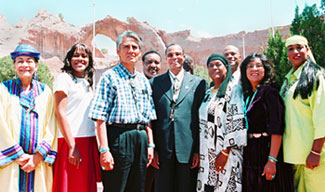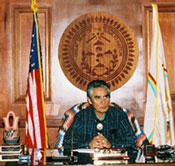
(FinalCall.com) – After the brief visit to the capital of the Navajo Nation in Arizona, priority issues emerged that revealed not only the richness of the tribe, but also its vulnerabilities. Here is a brief overview of 10 valuable elements of the Navajo life and struggle in North America.
1. The Navajo Nation is the largest federally recognized Native American tribe in the United States, with an estimated 300,000 members. The 83-year-old nation is the only native Indigenous tribe to have signed a treaty with the U.S. government, implicitly establishing recognition of its sovereignty as a nation.
2. The Navajo Nation is also recognized as a nation by the United Nations, representing other existing native tribes in this country, which is reflected in its participation in the drafting of the UN Draft Declaration on the Rights of Indigenous Peoples.
3. The tribal government of Navajoland consists of three branches: executive, legislative and judicial. The Navajo Nation Council has the authority to pass laws that govern the Navajo Nation, members of the Navajo Nation, and certain conduct of non-member Indians and non-Indians within the territorial boundaries of the Navajo Nation. An 88-member, popularly elected Council represents 110 local government subdivisions, or chapters, throughout Navajoland. Twelve standing committees carry out legislative work when the council is not in session.
4. Spanning 27,000 square miles across the states of Arizona, New Mexico and Utah, the Navajo land is not referred to as a reservation. Navajoland is comprised of the original treaty reservation, trust lands, allotted land and purchased land. The approximately 18 million acres of land, which is highly remote and isolated, is rich in oil, surface ground water, coal and natural gas.
5. While maintaining focus on retaining its traditional ways through initiatives like the Dine Fundamental Law, the Navajo Nation has also kept a keen eye on the future by installing a telecommunications infrastructure that links Navajo chapters and households through its fiber optic network.
6. The Four Corners–where the states of Arizona, Colorado, Utah and New Mexico converge–is one of the richest sources of this continent’s mineral wealth. As a result, the historic and contemporary relationship between the native tribes that live in this region and the oil and gas companies has been rife with tension and conflicts. From government negligence in holding corporations accountable to contracts to the reckless abandon of corporate natural resource exploration, accusations have been hurled of energy exploitation, resource corruption and land desecration.
7. Disputes over the First Americans claims to water rights are not unique to the Navajo, however, their battle included a lawsuit against the federal government for un-quantified Colorado River water rights. One of its tributaries, the San Juan River, is the center of a contentious yet unprecedented settlement between the Navajo and New Mexico. The water rights settlement provides for a 250-mile pipeline–of which the Navajo would control 36,000 acre-feet–that would bring water for use or lease in the Navajo communities in New Mexico. It also has $800 million water infrastructure projects attached to it.

8. An estimated 95 percent of businesses currently operating on Navajoland are not owned by Navajo. The Navajo dollar does not circulate even once within Navajoland. The Navajo are presently not a gaming tribe that operates casinos on its land. It receives federal funding and grants to sustain its development.
9. “We do not inherit the Earth from our ancestor, we borrow it from our children,” says a Native American proverb. The Navajo passed a Dine Natural Resources Protection Act in 2005, which prohibits uranium mining or processing within the Navajo Nation, as a result of the water and land contamination and a radioactive spill caused by uranium mining and processing on its lands.
10. The president of the Navajo Nation, Joe Shirley, has been reaching out for help and unity with Black and Indigenous communities, domestic and abroad, to assist in reversing the disintegrating infrastructure and neglect of Navajo communities. He has worked with the League of United Latin American Citizens, the oldest and largest Latino membership organization, in 2005 to fight against new uranium mines in territories that would affect both Latino and Native peoples. As recently as June this year, he hosted Indigenous leaders from Australia to discuss common issues, problems and solutions.












